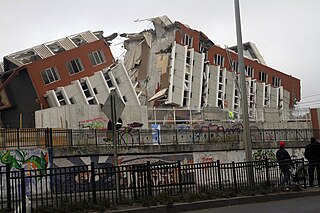Related Research Articles

Concepción is a city and commune in south-central Chile, and the geographical and demographic core of the Greater Concepción metropolitan area, one of the three major conurbations in the country. It has a significant impact on domestic trade being part of the most heavily industrialized region in the country. It is the seat of the Concepción Province and the capital of the Bío Bío Region. It sits about 500 km south of the nation's capital, Santiago.

The Maule Region is one of Chile's 16 first order administrative divisions. Its capital is Talca. The region derives its name from the Maule River which, running westward from the Andes, bisects the region and spans a basin of about 20,600 km2. The Maule river is of considerable historic interest because, among other reasons, it marked the southern limits of the Inca Empire.

The Biobío Region is one of Chile's sixteen regions. With a population of 1.5 million, thus being the third most populated region in Chile, it is divided into three provinces: Arauco, Biobío and Concepción. The latter contains its capital and largest city, Concepción, a major city and metro area in the country. Los Ángeles, capital of the Biobío Province, is another important city in the region.

Talcahuano is a port city and commune in the Biobío Region of Chile. It is part of the Greater Concepción conurbation. Talcahuano is located in the south of the Central Zone of Chile.
This article covers the electoral division of Chile, which involves two distinct systems:
- Chamber of Deputies and Senate: Chile is divided into electoral districts and senatorial constituencies for the election of members of the Chamber of Deputies and the Senate.
- Regional Councils: For the election of members of the Regional Councils, Chile is divided into provincial constituencies, with each province generally corresponding to one constituency, although some provinces are further divided into multiple constituencies.

The Biotren is an at-grade urban commuter rail system that serves a large part of the city of Concepción, Chile, capital of the region of Bío-Bío, also known as Greater Concepción or Concepción Metropolitan Area, both synonyms of "city" according to the urbanistic standards and laws of Chile, of which this city is the second biggest, most populous and important of the country. Biotren connects the boroughs or comunas of Concepción Centro, Talcahuano, Hualpén, San Pedro de la Paz, Chiguayante and Hualqui. The system is managed by Ferrocarriles Suburbanos de Concepción S.A. (Fesub), which name comes from the former metrorail system of the city and is a subsidiary of Empresa de los Ferrocarriles del Estado (EFE), Chilean State Railways. Biotren is part of the Plan and Authority of Integrated Transit of Concepción, Biovías.

Club Deportivo Universidad de Concepción, also known as Universidad de Concepción, are a Chilean football club based in Concepción, that is a current member of the Primera B. The club's home stadium is the Estadio Ester Roa de Concepción, which has a 30,480-spectator capacity.

Carriel Sur International Airport is located in Talcahuano, Greater Concepción in the Bío Bío Region, 8 km (5 mi) from Concepción downtown. It is one of the largest airports in Chile and serves domestic traffic for LATAM Airlines, JetSmart and Sky Airline. It also serves as a primary alternate airport for Arturo Merino Benitez Airport, usually receiving international traffic from Santiago when that airport closes due to weather.

Central Chile is one of the five natural regions into which CORFO divided continental Chile in 1950. It is home to a majority of the Chilean population and includes the three largest metropolitan areas—Santiago, Valparaíso, and Concepción. It extends from 32° south latitude to 37° south latitude.

Concepción Province is one of four provinces of the Chilean region of Bío Bío (VIII). Its capital, Concepción, is part of the Greater Concepción conurbation, the nation's second largest metropolitan area after Santiago.

The Andalién River is a river in the province of Concepción, in the Bío Bío Region of Chile. It drains the western side of Chile's Cordillera de la Costa and has a total length of 42 kilometres (26 mi). It is one of the two rivers that bracket the city of Concepción.

The 2010 Chile earthquake and tsunami occurred off the coast of central Chile on Saturday, 27 February at 03:34:12 local time, having a magnitude of 8.8 on the moment magnitude scale, with intense shaking lasting for about three minutes. It was felt strongly in six Chilean regions that together make up about 80 percent of the country's population. According to the United States Geological Survey (USGS) the cities experiencing the strongest shaking—VIII (Severe) on the Mercalli intensity scale (MM)—were Concepción, Arauco, and Coronel. According to Chile's Seismological Service, Concepción experienced the strongest shaking at MM IX (Violent). The earthquake was felt in the capital Santiago at MM VII or MM VIII. Tremors were felt in many Argentine cities, including Buenos Aires, Córdoba, Mendoza, and La Rioja. Tremors were felt as far north as the city of Ica in southern Peru. It is the largest earthquake to hit Chile since the 1960 Valdivia earthquake. A 2014 study contended that water pressure built up between the two plates had been the catalyst.
Estación Yumbel is a town in Biobío Region, Chile. It belongs to the commune of Yumbel and is administered by the municipal government of that city. The town lies along the main Chilean railway line south. It lies about 5.5 kilometers south of Yumbel.